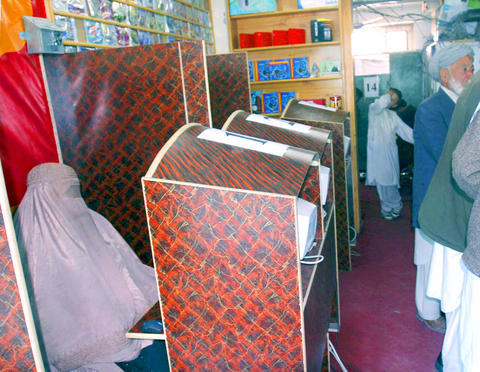In an Internet age, al-Qaeda prizes geek jihadis as much as would-be suicide bombers and gunmen. The terror network is recruiting computer-savvy technicians to produce sophisticated Web documentaries and multimedia products aimed at Muslim audiences in the US, Britain and other Western countries.
Already, the terror movement's al-Sahab production company is turning out high quality material, some of which rivals productions by Western media companies. The documentaries appear regularly on Islamist Web sites, which al-Qaeda uses to recruit followers and rally its supporters.
That requires people whose skills go beyond planting bombs and ambushing US patrols in Iraq and Afghanistan.

PHOTO: AP
"The al-Qaeda men who are coming today are not farmers, illiterate people," said Qari Mohammed Yusuf, an Afghan and self-declared al-Sahab cameraman. "They are PhDs, professors who know about this technology. Day by day they are coming. Al-Qaeda has asked them to come."
It was impossible to verify Yusuf's claim, although a former police chief in Yusuf's home province of Kunduz verified his links to al-Qaeda and the Taliban. Yusuf's information has proven reliable in the past.
Nevertheless, Western experts who monitor Islamist Web sites say the technical quality of al-Qaeda postings has dramatically increased from the grainy, amateurish images that were the hallmark of al-Sahab's work only a few years ago.
Now, postings are often in three languages -- Arabic, English and Urdu, the language of Pakistan where al-Qaeda hopes to draw fresh recruits. Videos look like professionally edited documentaries or television news broadcasts, with flashy graphics, maps in the background and split screens.
Footage lifted from Arab and Western television is often interlaced into the videos -- and al-Sahab appears to have a wide-ranging video library.
A speech by deputy al-Qaeda leader Ayman al-Zawahri issued to mark last year's anniversary of the Sept. 11, 2001, attacks included television interviews with wounded US soldiers, CIA analysts and talking-head journalists and experts, excerpts from a press conference by US President George W. Bush, audiotape of Malcolm X, even old World War II footage -- all edited in to back al-Zawahri's case that the US is losing the war on terror.
"What has changed dramatically is the quality, with documentaries and messages sometimes in three languages," said Rita Katz, director of SITE Intelligence Group, a US terrorism research center. "They are trying to outreach to as many people as possible."
Use of the Internet enables al-Qaeda to reach a broad global audience within the worldwide Muslim community rather than having to rely on Arabic language satellite stations, whose audiences are limited to the Middle East and who exercise some degree of editorial control.
"What is really amazing to me is watching how would-be terrorists living in the West are drawn in and captivated by al-Sahab videos," said Evan Kohlmann, a terror consultant for Globalterroralert.com.
Katz said the quality of some recent al-Sahab productions was "good enough to be on the Discovery Channel."
"We are not talking about people who don't know technology," she said. "They are very skilled. Al-Sahab must have a large team of people who have specific computer skills."
At the same time, the number of top quality al-Qaeda productions is on the rise.
According to the IntelCenter, a private US counterterrorism organization, al-Qaeda's propaganda wing produced and posted 74 video programs last year, an increase of 16 over 2006.
"It is clear that significant resources and efforts are being expended by al-Sahab to produce and release more videos than ever before and with consistently faster turnaround times than ever previously seen," IntelCenter said in a report last year.
Interviewed in a car with tinted windows as it swerved through colorful buses and ox-drawn carts, the bearded Yusuf outlined how al-Qaeda has jumped into the Internet age.
Instead of elaborate studios and equipment, the geek jihadis use laptops, generators and the right software to edit their material. For transmission, all they need is a high-speed Internet connection, which is available at scores of Internet cafes in towns and cities throughout Pakistan and Afghanistan.
Yusuf boasted that he once transmitted video from an Internet cafe across the street from the Afghan Ministry of Interior in Kabul.
Katz said producing propaganda videos for al-Sahab is a three-step process.
The first is to shoot the video. The second step -- the most time-consuming -- is to edit and produce the material, a process which requires skilled technicians but can be done in a simple mud hut anywhere in Afghanistan or the border area of Pakistan.
Once the material is ready, step three is transmitting through an Internet cafe.
"The al-Sahab man doesn't have to lug his computer on his back into the cafe," Katz said. "All he needs is a small USB stick and the high-speed Internet connection."
Al-Qaeda technicians have also become skilled at evading US detection techniques. Katz said they often use techniques such as "proxy servers" to disguise the point of origin.
"The al-Sahab people know and study technology, the latest law enforcement techniques," Katz said. "They know they can transfer files and they know not to transfer the entire file, to divide it into small pieces that eventually is stored in a single location."
Yusuf said al-Qaeda maintains its own cyberspace library, storing material in a secret server or servers so that the al-Sahab members do not have to keep incriminating material on their own laptops.
"There is a plan to make al-Sahab very big," Yusuf said. "It is part of the strategy. There are two parts. One is the fighting and the other part of the war is the media. We should carry out the media war because it inspires our people to come and fight."

TRAGEDY STRIKES TAIPEI: The suspect died after falling off a building after he threw smoke grenades into Taipei Main Station and went on a killing spree in Zhongshan A 27-year-old suspect allegedly threw smoke grenades in Taipei Main Station and then proceeded to Zhongshan MRT Station in a random killing spree that resulted in the death of the suspect and two other civilians, and seven injured, including one in critical condition, as of press time last night. The suspect, identified as a man surnamed Chang Wen (張文), allegedly began the attack at Taipei Main Station, the Taipei Fire Department said, adding that it received a report at 5:24pm that smoke grenades had been thrown in the station. One man in his 50s was rushed to hospital after a cardiac arrest

SAFETY FIRST: Double the number of police were deployed at the Taipei Marathon, while other cities released plans to bolster public event safety Authorities across Taiwan have stepped up security measures ahead of Christmas and New Year events, following a knife and smoke bomb attack in Taipei on Friday that left four people dead and 11 injured. In a bid to prevent potential copycat incidents, police deployments have been expanded for large gatherings, transport hubs, and other crowded public spaces, according to official statements from police and city authorities. Taipei Mayor Chiang Wan-an (蔣萬安) said the city has “comprehensively raised security readiness” in crowded areas, increased police deployments with armed officers, and intensified patrols during weekends and nighttime hours. For large-scale events, security checkpoints and explosives

A car bomb killed a senior Russian general in southern Moscow yesterday morning, the latest high-profile army figure to be blown up in a blast that came just hours after Russian and Ukrainian delegates held separate talks in Miami on a plan to end the war. Kyiv has not commented on the incident, but Russian investigators said they were probing whether the blast was “linked” to “Ukrainian special forces.” The attack was similar to other assassinations of generals and pro-war figures that have either been claimed, or are widely believed to have been orchestrated, by Ukraine. Russian Lieutenant General Fanil Sarvarov, 56, head

PUBLIC SAFETY: The premier said that security would be tightened in transport hubs, while President Lai commended the public for their bravery The government is to deploy more police, including rapid response units, in crowded public areas to ensure a swift response to any threats, President William Lai (賴清德) said yesterday after a knife attack killed three people and injured 11 in Taipei the previous day. Lai made the remarks following a briefing by the National Police Agency on the progress of the investigation, saying that the attack underscored the importance of cooperation in public security between the central and local governments. The attack unfolded in the early evening on Friday around Taipei Main Station’s M7 exit and later near the Taipei MRT’s Zhongshan